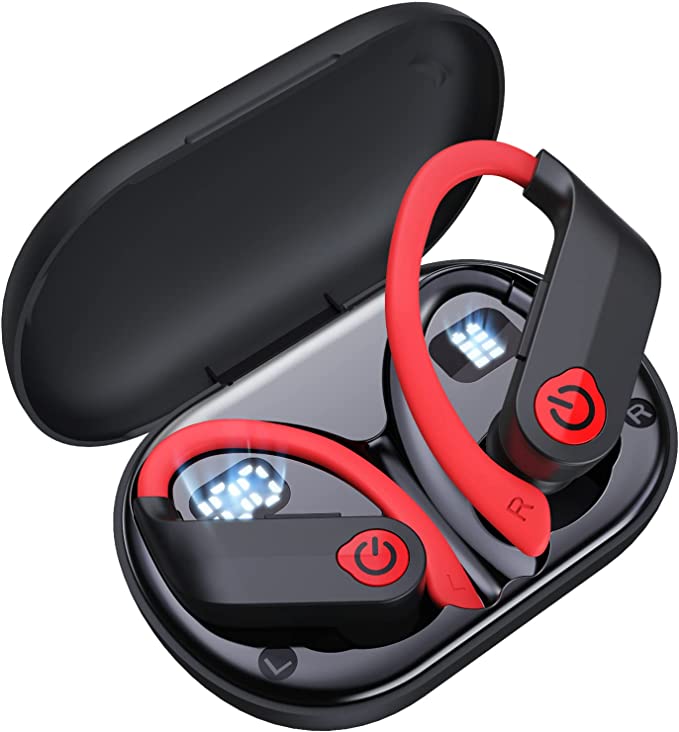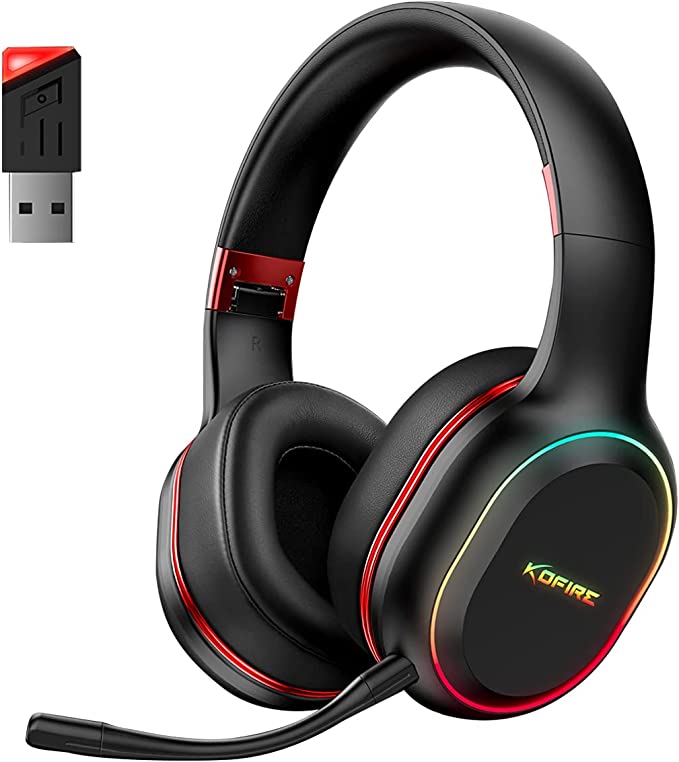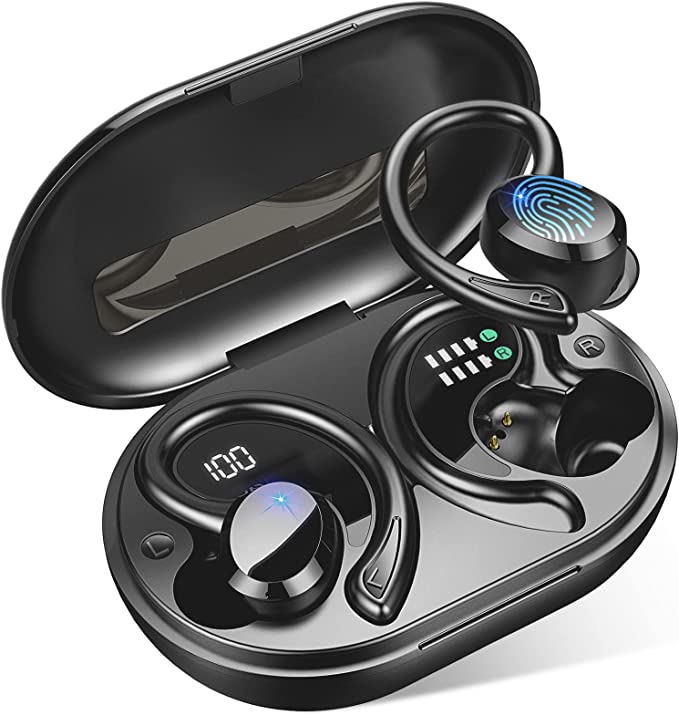The rhythm hits you. Legs pumping, heart soaring, the world melts away, replaced by the driving beat in your ears. Music isn’t just background noise during exercise; it’s fuel, focus, a metronome for your movement. But then, disaster strikes. A sudden jolt sends an earbud skittering across the pavement, or the connection sputters and dies mid-anthem. The quest for the perfect pair of sports wireless earbuds – ones that stay put, sound great, resist the elements, and go the distance – feels like a modern athletic challenge in itself.
You might come across models like the EUQQ Q63-5RED, whose online listing mentions features seemingly tailor-made for an active life: an over-ear design with stabilizing earhooks, Bluetooth 5.3 connectivity, an impressive-sounding claim of 120 hours of playtime, proclaimed “waterproof” capabilities, and a handy LED power display. Now, it’s crucial to state upfront: we don’t have independently verified performance data or specifications for this particular model, as the information comes solely from a product listing which also notes it’s currently unavailable. However, the types of features listed are common across many sports earbuds and offer us a fantastic springboard. Forget the marketing buzz for a moment. This isn’t a product review. Instead, consider this your expedition guide into the fascinating science and engineering that make such workout-ready audio possible. Let’s explore the why and how behind the technology designed to keep your soundtrack seamlessly synced with your sweat.

The Invisible Tether: Decoding Wireless Freedom with Bluetooth
Wireless earbuds feel like magic, but their core is pure radio science. Bluetooth, the technology that cuts the cord, is essentially a standardized way for devices to chat over short distances using radio waves in the busy 2.4 GHz frequency band (the same neighborhood used by Wi-Fi, microwaves, and more). It’s a type of Wireless Personal Area Network (WPAN), designed for low power consumption and simplicity.
When you pair your earbuds, they establish a secure, one-to-one conversation with your phone or watch. They agree on a common ‘language’ using specific Bluetooth profiles – like A2DP (Advanced Audio Distribution Profile) for streaming that stereo music. But how does this connection stay stable when you’re bouncing down a trail or weaving through a crowded gym filled with other wireless signals?
The secret lies, in part, in a clever technique called Frequency Hopping Spread Spectrum (FHSS). Imagine trying to have a private conversation in a loud, crowded party. Instead of shouting over the noise, you and your friend agree on a secret pattern: you’ll jump between different quiet corners of the room, speaking briefly in each before moving to the next. Bluetooth does something similar, rapidly hopping between dozens of different frequencies within that 2.4 GHz band hundreds of times per second. This makes the connection incredibly resilient to interference. If one frequency ‘channel’ is noisy or occupied, the system quickly jumps to a clearer one, keeping your audio stream smooth. It’s a concept with fascinating roots – actress Hedy Lamarr and composer George Antheil conceived a similar frequency-hopping system during World War II for guiding torpedoes!
Listings often mention specific Bluetooth versions, like the “Bluetooth 5.3” noted for the EUQQ Q63-5RED example. Each new version, standardized by the Bluetooth Special Interest Group (SIG), typically aims for improvements. While the actual performance always depends on the specific chips and software used in both the earbuds and your source device, Bluetooth 5.3 generally targets enhancements like:
- Potentially Greater Stability & Efficiency: Features within 5.3 can help reduce interference further and allow devices to be more power-efficient, especially with the groundwork laid for LE Audio (Low Energy Audio) – a newer standard promising high-quality audio at lower power consumption.
- Connection Management: Enhancements might allow devices to manage connections more intelligently, potentially leading to faster pairing or smoother switching between sources.
For an athlete, this translates to fewer frustrating dropouts, potentially longer listening times between charges, and a more seamless experience overall. However, there’s another piece to the wireless puzzle: Codecs. These are like the compression algorithms used to shrink the digital audio file for transmission over Bluetooth. The most basic, universal codec is SBC, which gets the job done but isn’t always the best for sound quality or latency (that slight delay between seeing something on screen and hearing the sound). AAC (favored by Apple devices) and Qualcomm’s aptX family (common on Android) generally offer better sound quality and/or lower latency, crucial for watching videos or gaming without that annoying lip-sync lag. The codecs supported by both your earbuds and your phone determine the quality and responsiveness you actually experience.

Defying Gravity and Motion: The Ergonomic Genius of a Secure Fit
Physics is relentless during a workout. Every stride sends impact shockwaves through your body. Quick turns generate inertial forces. And then there’s sweat, acting like a lubricant. All these factors conspire to dislodge tiny objects nestled in your ears. This is where ergonomics – the science of designing for human use – becomes critical for sports earbuds.
The EUQQ Q63-5RED listing mentions an “Over Ear” form factor with earhooks. This is a classic solution to the stability problem. How does it work? The earhook loops over the top of your pinna (the visible part of your ear), using it as a natural anchor point. Think of it like a small, gentle lever system. It provides mechanical stability by:
- Counteracting Forces: The hook helps resist the downward pull of gravity and the outward/forward forces generated by bouncing and head movements.
- Distributing Weight: It spreads the earbud’s (admittedly small) weight over a larger area, potentially improving comfort during long wear compared to designs relying solely on pressure inside the ear canal.
- Providing Redundancy: Even if the in-ear seal momentarily breaks, the hook keeps the earbud from falling completely off.
The goal isn’t just to prevent catastrophic drops, but to maintain a consistent position. Why? Because the seal created by the eartip inside your ear canal is crucial for good bass response and noise isolation. If the earbud constantly shifts, the sound quality fluctuates, and you’re constantly tempted to fiddle with it, breaking your focus.
Of course, earhooks aren’t the only solution. Many popular sports earbuds use wingtips (small, flexible fins that tuck under the antihelix fold inside your ear) or rely purely on a very precise in-ear fit achieved through extensive ear-shape modeling and a variety of eartip sizes and materials (like silicone or memory foam). The “best” ergonomic design is often subjective and depends on individual ear shape and activity type. However, the underlying principle remains the same: leveraging the ear’s complex geometry to create a stable platform that can withstand the dynamic forces of exercise, allowing you to focus on your performance, not your gear.

The Powerhouse Within: Understanding Battery Endurance Claims
A claim like “120H Playtime” on an earbud listing immediately catches the eye. But hold on – does that mean 120 continuous hours of playback from the tiny earbuds themselves? Almost certainly not. This figure typically represents the total system endurance: the playtime of the earbuds on a single charge plus the additional charges provided by their portable charging case.
The magic behind this endurance lies in Lithium-ion (Li-ion) or Lithium-polymer (Li-Po) batteries, the unsung heroes of nearly all modern portable electronics. What makes them so special? It boils down to energy density. Think of it like how much energy you can pack into a given weight or volume. Li-ion batteries are champions at this, allowing engineers to fit significant power into the small confines of an earbud and its case.
How do they work? Imagine the battery’s internal structure as two multi-layered ‘hotels’ (the electrodes: anode and cathode) separated by a ‘highway’ (the electrolyte). Tiny charged particles, the lithium ions, are the ‘guests’. When you charge the battery, energy pushes these ions from the cathode ‘hotel’ across the electrolyte ‘highway’ to check into the anode ‘hotel’. When you use the earbuds, the process reverses: the ions willingly travel back to the cathode, releasing energy in the form of electrical current to power your music. This “checking in and out” process (scientifically known as intercalation) can happen hundreds of times.
The charging case acts as a larger ‘lobby’ or power bank with its own, bigger Li-ion battery. When you dock your earbuds, the case tops up their smaller internal batteries. So, if the earbuds offer, say, 8 hours per charge, and the case holds enough power for about 14 additional full charges, you reach that impressive-sounding total figure (8 + 14*8 = 120 hours).
However, real-world battery life is a slippery fish, influenced by many factors:
- Volume Level: Louder music demands more power.
- Bluetooth Connection & Codec: A stable connection and an efficient codec (like AAC or certain LE Audio codecs) consume less energy than a struggling connection or a power-hungry codec.
- Temperature: Extreme cold or heat can temporarily reduce battery performance and accelerate long-term degradation.
- Battery Age: Like all rechargeable batteries, Li-ion batteries degrade over time. With each charge/discharge cycle, their maximum capacity slightly decreases. That 8-hour initial playtime might become 6 or 7 hours after a couple of years of regular use.
Understanding this helps set realistic expectations. That giant playtime number relies heavily on the case, and your actual listening habits will dictate how often you need to recharge the whole system.

Weathering the Storm: Making Sense of “Waterproof” Claims
“Waterproof” – it sounds definitive, reassuring. Especially for sports earbuds destined to encounter the salty deluge of sweat or an unexpected downpour. But in the world of engineering, “waterproof” is often less absolute and more accurately described as water resistance, measured against a specific standard. Why the nuance? Because protecting sensitive electronics from liquids is a significant challenge.
Sweat, in particular, isn’t just water. It contains salts and other electrolytes, making it conductive and potentially corrosive over time. It’s a far bigger threat than a splash of pure H₂O. This is why a standardized measure of protection is crucial. That standard is the IP Code (Ingress Protection Code), defined by the International Electrotechnical Commission (IEC) in standard 60529.
You’ll often see ratings like IPX4, IPX7, etc. Let’s break it down:
* IP: Stands for Ingress Protection.
* First Digit (or ‘X’): Rates protection against solid objects (dust, dirt). ‘X’ means it hasn’t been specifically tested or rated for solid ingress.
* Second Digit: Rates protection against liquids. This is the critical one for sports earbuds. Here are common levels:
* IPX4: Protected against splashing water from any direction. Think of this as the minimum standard for reliable sweat resistance and surviving light rain. Analogy: Wearing a basic poncho – good for drizzle, not a downpour.
* IPX5: Protected against low-pressure water jets from any direction. More robust than IPX4.
* IPX6: Protected against high-pressure water jets.
* IPX7: Protected against temporary immersion in water (up to 1 meter deep for up to 30 minutes). Analogy: Wearing a full raincoat, maybe even briefly falling into a puddle.
* IPX8: Protected against continuous immersion under conditions specified by the manufacturer (deeper than 1 meter).
So, when a product like the example EUQQ Q63-5RED is simply listed as “Waterproof” without a specific IPX rating, it’s ambiguous. Is it merely splash-proof (IPX4), or can it handle a brief dunk (IPX7)? You don’t know. Achieving these ratings involves careful design: tight seams, rubber or silicone gaskets sealing entry points (like charging ports or microphone openings), waterproof membranes over speaker drivers, and sometimes specialized nano-coatings that repel water at a microscopic level.
The takeaway for athletes is clear: look for a specific IPX rating that matches your needs. If you sweat heavily or run in all weather, IPX4 is a minimum baseline, while higher ratings offer greater peace of mind. Don’t be swayed by a vague “waterproof” claim alone.

Simple Signals: The Humble Brilliance of the LED Indicator
Amidst the complex science of wireless audio and ergonomic design, some features are elegantly simple yet incredibly useful. The LED Power Display, mentioned for the EUQQ Q63-5RED, is a prime example. These tiny lights on the charging case (and sometimes the buds themselves) serve a straightforward purpose: providing visual feedback on battery status.
The technology behind them is the Light Emitting Diode (LED). At its core, an LED is a semiconductor device. When electricity flows through its specially engineered materials (across something called a p-n junction), electrons release energy in the form of photons – tiny packets of light. LEDs are remarkably energy-efficient compared to older indicator technologies, produce little heat, and can be made incredibly small. This makes them perfect for providing quick status updates without significantly draining the battery they’re monitoring. A simple color code (like green for full, orange for medium, red for low) or a series of dots can instantly tell you if the case needs charging or if the earbuds are ready for another session. It’s a small touch, but it eliminates the guesswork and the unwelcome surprise of finding your gear dead right before a workout.

Bringing It All Together: The Symphony of Sports Audio Tech
We’ve journeyed through radio waves, biomechanics, electrochemistry, and material science – all converging within the compact form of a modern sports wireless earbud. It’s tempting to view features like Bluetooth 5.3, earhooks, long battery life, and IP ratings as a simple checklist. But the real magic lies in understanding how these technologies, born from distinct scientific principles, work together in a carefully orchestrated symphony to enhance the athletic experience.
An energy-efficient Bluetooth chip (leveraging LE Audio concepts) directly contributes to longer listening times, complementing the Li-ion battery’s capacity. A secure ergonomic fit not only prevents annoying readjustments but also ensures a consistent acoustic seal, maximizing sound quality and potentially making noise isolation more effective. Robust water resistance safeguards all the intricate internal electronics from the inevitable sweat and grime of a hard workout.
Understanding these underlying principles empowers you. You can look beyond the marketing superlatives and ask smarter questions. How stable is the connection really likely to be in a crowded environment? What specific IPX rating does it have, and does that match my activity? Is that impressive battery life figure based on the buds alone, or heavily reliant on the case?

Conclusion: Listen Smarter, Move Freer
The technology packed into today’s sports wireless earbuds is a testament to human ingenuity – a blend of physics, chemistry, engineering, and design focused on freeing your movement while delivering your personal soundtrack. Whether exemplified by the listed features of a model like the EUQQ Q63-5RED or any other pair you encounter, the core science remains fascinating.
From the invisible dance of radio waves in Bluetooth keeping your music flowing, to the clever ergonomic designs that defy gravity, the miniature power plants storing hours of energy, and the protective shields warding off the elements – each feature rests on a foundation of scientific understanding.
The goal of this exploration hasn’t been to review a specific product, but to illuminate the science behind the products. By appreciating the why and how of these technologies, you become a more informed consumer, better equipped to choose tools that truly enhance your active life. So, the next time you pop in your earbuds and hit the track, take a moment to appreciate the incredible symphony of science working silently to keep you moving to the beat. Keep asking questions, keep learning, and listen smarter.



